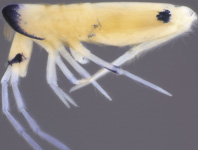Abstract
Garra turcica, from the rivers Kızıl, Seyhan, Ceyhan and Arsuz, is re-diagnosed and re-described. The species was treated as a synonym of G. rufa but molecular data strongly suggest that G. turcica represent an own species. It is distinguished from G. rufa by being more slender bodied, having a blunt snout and usually a short rostral cap. Based on COI sequence data, G. turcica is closely related to a group of species from the Persian Gulf basin, all having very small distribution areas nested in or adjacent to the range of G. rufa. The closest relatives of G. turcica are G. elegans, G. mondica and G. amirhosseini from which G. turcica differs by having a free posterior edge of the mental disc, the predorsal back covered by scales and the scales on the chest about as large as on the belly as well as by a minimum K2P distance of 2.2% in its COI barcode region.
References
Akaike, H. (1973) Information theory and an extension of the Maximum Likelihood principle. In: Petrov, B.N. & Csaki, F. (Eds.), Proceedings of the second International Symposium on Information Theory, Budapest, 1973, pp. 267–281.
Behrens-Chapuis, S., Herder, F., Esmaeili, H.R., Freyhof, J., Hamidan, N.A., Özuluğ, M., Šanda, R. & Geiger, M.F. (2015) Adding nuclear rhodopsin data where mitochondrial COI indicates discrepancies—can this marker help to explain conflicts in cyprinids? DNA Barcodes, 3, 187–99.
https://doi.org/10.1515/dna-2015-0020Bostancı, Z. (2006) Seyhan, Ceyhan ve Asi Nehirlerinde yaşayan Balıkların Sistematik Yönden incelenmesi. Karadeniz Teknik Üniversitesi Fen Bilimleri Enstitüsü, Balıkçılık Teknolojisi Mühendisliği Anabilim Dalı. Yüksek Lisans Tezi, Trabzon, 113 pp.
Durna, S., Bardakci, S. & Degerli, N. (2010) Genetic diversity of Garra rufa Heckel, 1843 (Teleostei: Cyprinidae) in Anatolia. Biochemical Systematics and Ecology, 38, 83–92.
https://doi.org/10.1016/j.bse.2009.12.009
Coad, B.W. (2010) Freshwater fishes of Iraq. Pensoft Series Faunistica, 93, 1–275, 16 pls.Esmaeili, H.E., Sayyadzadeh, G., Coad, B.W. & Eagderi, S. (2016) Review of the genus Garra Hamilton, 1822 in Iran with description of a new species: a morpho-molecular approach (Teleostei: Cyprinidae). Iranian Journal of Ichthyology, 3 (2), 82–121.
Ergüden, S.A. & Göksu, M.Z.L. (2012) The fish fauna of the Seyhan dam lake (Adana). Journal of Fisheries Sciences, 6, 39–52.
https://doi.org/10.1111/j.1471-8286.2007.01748.x
Geiger, M.F., Herder, F., Monaghan, M.T., Almada, V., Barbieri, R., Bariche, M., Berrebi, P., Bohlen, J., Casal-Lopez, M., Delmastro, G.B., Denys, G.P.J., Dettai, A., Doadrio, I., Kalogianni, E., Kärst, H., Kottelat, M., Kovačić, M., Laporte, M., Lorenzoni, M., Marčić, Z., Özuluğ, M., Perdices, A., Perea, S., Persat, H., Porcelotti, S., Puzzi, C., Robalo, J., Šanda, R., Schneider, M., Šlechtová, V., Stoumboudi, M., Walter, S. & Freyhof, J. (2014) Spatial heterogeneity in the Mediterranean Biodiversity Hotspot affects barcoding accuracy of its freshwater fishes. Molecular Ecology Resources, 14, 1210–1221.
https://doi.org/10.1111/1755-0998.12257.Hall, T.A. (1999) BioEdit: a user-friendly biological sequence alignment editor and analysis program for Windows 95/98/NT. Nucleic Acids Symposium Series, 41, 95–98.
Hamidan, N.A., Geiger, M.F. & Freyhof, J. (2014) Garra jordanica, a new species from the Dead Sea basin with remarks on the relationship of G. ghorensis, G. tibanica and G. rufa (Teleostei: Cyprinidae). Ichthyological Exploration of Freshwaters, 25 (3), 223–236.
Hashemzadeh Segherloo, I., Normandeau, E., Benestan, L., Rougeux, C., Coté, G., Moore, J.S., Ghaedrahmati, N., Abdoli, A. & Bernatchez, L. (2018) Genetic and morphological support for possible sympatric origin of fish from subterranean habitats. Scientific Report, 13, 8 (1), 2909.
https://doi.org/10.1038/s41598-018-20666-wIvanova, N.V., Zemlak, T.S., Hanner, R.H. & Hebert, P.D.N. (2007) Universal primer cocktails for fish DNA barcoding. Molecular Ecology Notes, 7, 544–548.
https://doi.org/ 10.1111/j.1471-8286.2007.01748.xKaraman, M.S. (1971) Revision der Barben Europas, Vorderasiens und Nordafrikas. Mitteilungen aus dem Hamburgischen Zoologischen Museum und Institut, 67, 175–254.
Khaefi, R., Esmaeili, H.R., Geiger, M.F. & Eagderi, S. (2017) Taxonomic review of the cryptic Barbus lacerta species group with description of a new species (Teleostei: Cyprinidae). FishTaxa, 2, 90–115.
Kottelat, M. & Freyhof, J. (2007) Handbook of European freshwater fishes. Kottelat, Cornol and Freyhof, Berlin, xiv + 646 pp.
Krupp, F. (1985) Systematik und Zoogeographie der Süsswasserfische des levantinischen Grabenbruchsystems und der Ostküste des Mittelmeers. Dissertation, Johannes Gutenberg Universität, Mainz, 215 pp.
Lyon, R.G., Geiger, M.F. & Freyhof, J. (2016) Garra sindhi, a new species from the Jebel Samhan nature Reserve in Oman (Teleostei: Cyprinidae). Zootaxa, 4154 (1), 79–88.
https://doi.org/10.11646/zootaxa.4154.1.5
Menon, A.G.K. (1964) Monograph of the cyprinid fishes of the genus Garra Hamilton. Memoirs of the Indian Museum, 14, 173–260.Nebeshwar, K. & W. Vishwanath. (2013). Three new species of Garra (Pisces: Cyprinidae) from north-eastern India and redescription of G. gotyla. Ichthyological Exploration of Freshwaters, 24, 97–120.
Posada, D. (2008) jModelTest: Phylogenetic Model Aver- aging. Molecular Biology and Evolution, 25, 1253–1256.
https://doi.org/10.1093/molbev/msn083Sayyadzadeh, G., Esmaeili, H.R. & Freyhof, J. (2015) Garra mondica, a new species from the Mond River drainage with remarks on the genus Garra from the Persian Gulf basin in Iran (Teleostei: Cyprinidae). Zootaxa, 4048 (1), 75–89.
https://doi.org/10.11646/zootaxa.4048.1.4Stiassny, M.L.J. & Getahun, A. (2007) An overview of Labeonin relationships and the phylogenetic placement of the Afro-Asian genus Garra Hamilton, 1822 (Teleostei: Cyprinidae), with the description of five new species of Garra from Ethiopia, and a key to all African species. Zoological Journal of the Linnean Society, 150, 41–83.
https://doi.org/10.1111/j.1096-3642.2007.00281.x
Tamura, K., Peterson, D., Peterson, N., Stecher, G., Nei, M. & Kumar, S. (2013) MEGA5: Molecular Evolutionary Genetics Analysis using Maximum Likelihood, Evolutionary Distance, and Maximum Parsimony Methods. Molecular Biology and Evolution, 28, 2731–2739.
https://doi.org/10.1093/molbev/msr121

